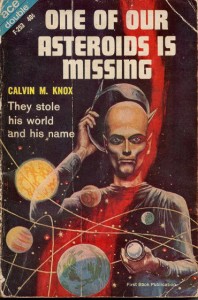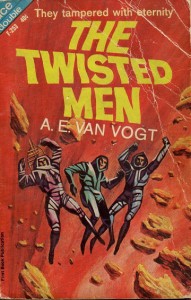Book Review: One of Our Asteroids is Missing | The Twisted Men by Robert Silverberg (writing as Calvin M. Knox) and A. E. Van Vogt, respectively.
This is another Ace Double, two books in one, upside down from each other. According to Larry Niven, during the 1960s Ace Books was known for being particularly skinflint towards authors, so would only be sold to if all other SF publishers turned down the book, and the writer just needed some cash in hand, because royalties and overseas sales would never be forthcoming. When Tom Doherty bought the publishing house, he didn’t talk to any of the writers who’d worked for them, but did do a two-year search for legal complaints. There were none–because the writers had all learned that it was useless. (Mr. Doherty reformed Ace Books’ payment policies, and a lot of authors finally got back payments.)
One of Our Asteroids Is Missing features a young asteroid prospector named John Storm (no relation) who is looking for rare metal deposits in the asteroid belt to feed Earth’s early 21st Century computer technology. He finds a jackpot, but between filing his claim on Mars and getting to Earth to set up the funding to get it mined, the computer network somehow loses his claim. And all of John Storm’s personal records! Since almost everything in the future society revolves around your existence in the computer network, being “unpersoned” like this is a terrible blow.
Of course, this complete erasure of John Storm’s identity belies the suggestion that he somehow screwed up the claim registration. A clumsy typist might have erased one record, but it would take money and dedication to pull this off. “Why?” then is the question; even a jackpot mining asteroid would hardly be worth this much effort, including a physical assassination attempt. John must return to the asteroid belt to investigate, and what he finds there could change everything!
To be honest, John’s struggles with the future bureaucracy are more interesting to me than the actual space adventure stuff. Anyone who’s had to deal with a petty official declaring that it must somehow be your mistake that caused their computer system to act unjustly can certainly identify.
John’s fiancee Liz seems to have no goals outside of marrying John whether or not he succeeds (though she would prefer he succeeds), and her offer of help is rejected because space is “too dangerous for a woman.” In our 21st Century, that would get a laugh. She also never learns what actually happened.
There’s an alien involved who looks nothing like the picture on the cover (which is awesomely SF in its own right) and Mr. Silverberg’s fascination with psychic powers shines through. It’s middling-grade but quite readable.
The Twisted Men is actually a collection of three longer stories by A.E. Van Vogt, too long to fit in a regular anthology, but not related enough to turn into a “fix-up” novel.
“The Twisted Men” itself stars Averill Hewitt, a scientist who has discovered that something strange and dangerous is going to happen to the sun in a few years. Apparently he is terrible at explaining his theory, because one person taking his metaphor and saying that said metaphor is not literally possible is enough to put Mr. Hewitt in the Jor-El category. Unlike Jor-El, however, Mr. Hewitt is able to build a full-size spaceship to go to the Proxima Centauri system to look for habitable planets.
He insists that it be staffed by personnel whose wives are pregnant, or can become so; it apparently doesn’t enter his mind that pregnant women might also have space-worthy skills. His own wife refuses to get on board and takes the children with her. This results in some sub-optimal personnel, including several religious fanatics and a captain who wants to marry his ward who doesn’t actually look eighteen. Skeeviness aside, this is the only available captain, so the Hope of Man is launched. Six years later, the ship is detected re-entering the solar system at enormous speed, and not responding to hails.
Naturally, Mr. Hewitt is tapped to try to discover what happened; what he discovers, and the implications, drive the rest of the story. The story is heavy on the speculative science, but not nearly as forward-thinking on the social end. There are some evocative passages as Hewitt explores the ship and struggles to understand what is going on.
“”The Star-Saint” is a planetary colonization story. Leonard Hanley is the leader of a group of colonists who are about to make planetfall only to discover that the previous batch of colonists have vanished, their village completely destroyed. Fortunately (or perhaps not), Mark Rogan has arrived to help out. Rogan is a mutant with strange powers and a detached attitude that drives most other men up the wall. Oddly, women seem to find Rogan extremely attractive. Hanley is unhappy about the help, but it’s not as though he’s got much choice.
Hanley thinks he’s figured out the problem, only to be told by Rogan that he’s actually made things much worse. The situation is finally brought to something of a compromise point–but Hanley suspects this colony will soon have several mutant babies, including his own wife’s. The treatment of women in this story is frankly kind of creepy, but the fact that it’s told from the perspective of the patriarchal and controlling Hanley means that we don’t know what actually happened.
“The Earth Killers” starts with America being attacked by an unknown party, which wipes out the major cities with atomic bombs. The only surviving witness is Morlake, a test pilot who was trying out an experimental “rockjet” near Chicago when the bombs fell. Unfortunately, the military outpost he manages to land at is run by a fool who has him arrested for treason rather than listen to the truth. Admittedly, the truth is pretty unbelievable–the bombs came from straight up, not in an arc.
It’s months before the remaining Americans can get around to realizing the importance of his testimony–and Morlake is able to uncover the shocking secret behind the war.
This story’s got a nice bite to it, especially since it avoids taking the easy route of making the villains Communists (as was the fashion at the time.)
The creepy treatment of women in the first two stories makes this set hard to recommend–mostly for Van Vogt completists.



I love the art work…..too bad the alien looks nothing like the one on the cover. He looks rather interesting to me.
This was fairly standard for science fiction of the period–writers were often lucky if the artist had been told what the story was about, let alone actually read it. Sometimes the publishers would just take art on spec and slap it on the next vaguely suitable book.